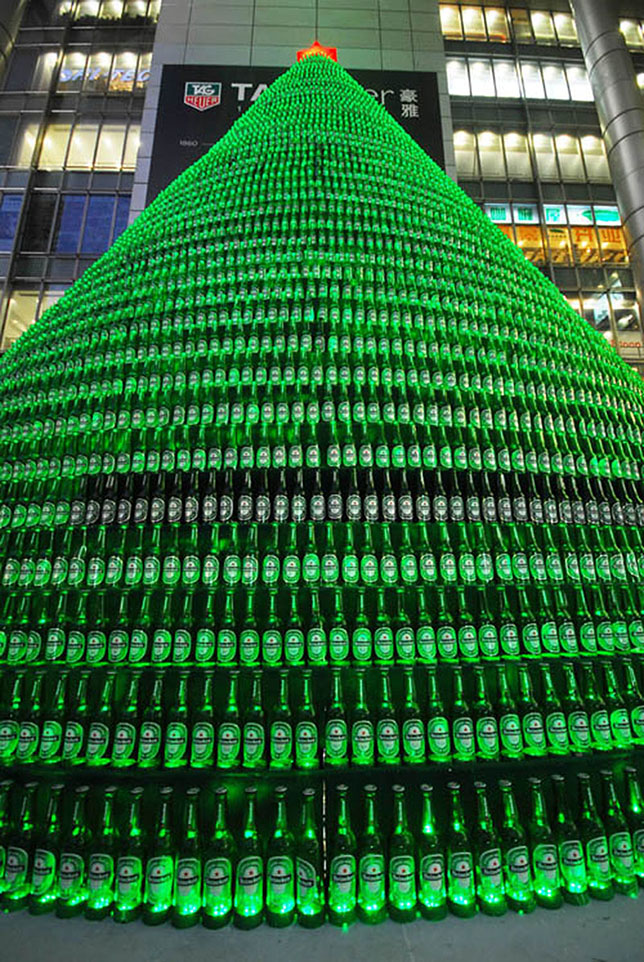Christmas has numerous traditions, of which perhaps none is more popular than a decorated tree. Whether real or artificial, Christmas trees are synonymous with the holiday. But how did trees become part of Christmas?
Trees have been used in rituals and as decorations since ancient times, thus making the source of the modern Christmas tree open to debate. However, many believe that it originated in Germany. It is claimed that in Germany about 723 the English missionary St. Boniface encountered pagans preparing a sacrifice at an oak tree dedicated to the god Thor (Donar). Boniface took an ax to the tree, and, when not struck down by their god, he proclaimed to the awed pagans that a nearby evergreen was their “holy tree.” Other sources report that a fir grew on the site of the fallen oak.
Whether that tale is true or not, evergreen trees became part of Christian rites in Germany, and in the Middle Ages “paradise trees” began to appear there. Meant to represent the Garden of Eden, these evergreen trees were hung with apples and displayed in homes on December 24, the religious feast day of Adam and Eve. Other decorations were added—Martin Luther reportedly first hung lighted candles on a tree in the 16th century—and paradise trees evolved into Christmas trees. By the 19th century, Christmas trees were a firmly established tradition in Germany.
As Germans migrated, they took Christmas trees to other countries, notably England. There, in the 1790s, Charlotte, the German-born wife of King George III, had trees decorated for the holiday. However, it was a German-born prince, Albert, and his wife, Britain’s Queen Victoria, who popularized the tradition among the British. The couple made Christmas trees a prominent part of the holiday’s festivities, and in 1848 an illustration of the royal family around a decorated tree appeared in a London newspaper. Christmas trees soon became common in English homes.
German settlers also introduced Christmas trees in the United States, though the custom was not initially embraced. Many Puritans opposed the holiday because of its pagan roots, and officials of the Massachusetts Bay Colony actually outlawed celebrating Christmas. Their dislike of the holiday was such that they even closed their churches on December 25. It wasn’t until the 1820s that Christmas began gaining popularity in America, and the country’s first Christmas tree reportedly was displayed in the 1830s. The Christmas tree’s popularity spread with the help of the influential magazine Godey’s Lady’s Book, which in 1850 published the 1848 illustration of the British royals, though the depiction of the family was altered to appear American. This and other efforts helped make Christmas trees popular in the United States by the 1870s.
Christmas trees spread around the world, but the tradition began to have a detrimental impact on forests, especially in Germany. As a result, Germans began making artificial goose-feather trees in the 1880s. These trees found their way to different countries, and over time the goose feathers were replaced by other materials. A notable development occurred in the 1930s, when a manufacturer of toilet bowl brushes allegedly used surplus product to create an artificial tree. These bristle trees gained in popularity but were later supplanted by aluminum and then plastic versions. In the United States, 84 percent of Christmas trees displayed by households in 2021 were artificial, according to data from the American Christmas Tree Association, while 16 percent were live.
© 2022. All content on this blog is protected by international copyright laws All images are copyrighted © by visualDiplomacy/Michel Bergeron or assignee. Apart from fair dealing for the purpose of private study, research, criticism or review as permitted under the Copyright Act, the use of any image from this site is prohibited unless prior written permission is obtained. All images used for illustrative purposes only

 |
| Chanel’s Christmas tree |
 |
| Sonia Rykiell’s Christmas tree |
 |
| Elie Saabl’s Christmas tree |
 |
| The Multicolored Murano Glass Christmas Tree, Italy |
 |
| Pierre Hermél’s Christmas tree |
 |
| Patrice Garderal’s Christmas tree |
 |
| the Rinddl’s Christmas tree |
 |
| JonOnel’s Christmas tree |
 |
| Francis Kurkdjian’s Christmas tree |
 |
| Diorl’s Christmas tree |
 |
| Jérôme Dreyfuss’ Christmas tree |
 |
| The Heineken Beer Bottle Tree, Shanghai |
 |
| Nina Ricci’s Christmas tree |
 |
| Jean Paul Gaultier’s Christmas tree |
 |
| Didier Ludotl’s Christmas tree |
 |
| Maison Martin Margielal’s Christmas tree |
 |
| Jean Paul Gaultier’s Christmas tree |
 |
| Diana VOon Furstenberg - The tree of Love |
 |
Louis Vuitton's Christmas tree
|
 |
| Jack Daniel's Barrel Tree, Lynchburg, Tn |
 |
| Dali Parfums' Christmas tree |
 |
Christopher Bailey’s creation featured over 100 umbrellas,
each finished in bespoke gold and silver metallic fabric, and thousands of
motion-sensor lights, programmed to sparkle and glitter as guests walked by the tree. |
 |
| Sand tree, West Palm beach, Fl |
 |
| Lobster Trap Christmas Tree in downtown Rockland, Maine |
 |
| Iris Cantabri by Guillaume Michel |
 |
| The Swarovski Crystal Color Changing Christmas Tree, Paris |
 |
| Red-Soled Christmas Trees For Christian Louboutin Boutiques |
 |
| Les Garçons' Christmas tree |
 |
| Hubcap Christmas tree, Baltimore |
 |
| Christian Dior’s Christmas tree |
 |
| Traffic light tree, London |
 |
| Tree by Paul McCarthy, 2014 |

































No comments:
Post a Comment